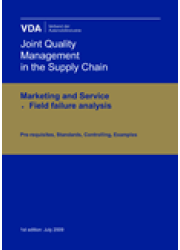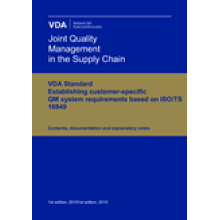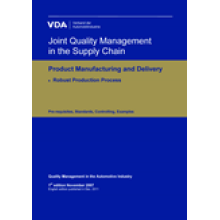Field failures analysis, Joint Quality Management in the Supply Chain Marketing and Service, 1st edition: July 2009
Quantity:
-
Add to Compare
Short description to VDA Volume “Field failures analysis”
Despite every effort in the development and production processes to provide mature, robust problem-free products to the customer, deviations from the expected performance may occur when the vehicle is in use. Depending on the problem, the defective parts or vehicle components are replaced and the vehicle manufacturer (OEM) or supplier may ask for them to be returned, via the OEM, for analysis.
The field failure analysis of defective parts returned from the field plays a fundamental and multiple role in this area of conflict between quality and costs. It is agreed that, of all the failures reported world-wide, an appropriate number will be returned to the component manufacturer, representing the failure event reported in the market (the so-called reference market procedure). The supplier carries out an analysis of the rejected parts. If a failure is verified, the supplier analyses the root cause and determines who caused the problem. A problem-solving process is initiated by the automobile manufacturer and/or the supplier, depending on who caused the problem.
Contents
|
2 |
Field failure analysis process |
|
2.1 |
Concept of the field failure analysis process |
|
2.2 |
Test status and test strategy in the field failure analysis |
|
2.3 |
Part Analysis |
|
3 |
The NTF process |
|
3.1 |
Triggering criteria |
|
3.2 |
Procedure |
|
3.3 |
Data collection and evaluation |
|
3.4 |
System tests |
|
3.5 |
Process study |
|
3.6 |
Software |
|
3.7 |
Communication / documentation |
|
3.8 |
Concluding the NTF process |
|
4 |
The problem-solving process |
|
4.1 |
Problem analysis |
|
4.2 |
The 8D-method |
|
5 |
Planning the field failure analysis process |
|
5.1 |
Test specification for the part analysis |
|
5.1.1 |
Description of the test layout and configuration |
|
5.1.2 |
Test characteristics with specified limits |
|
5.1.3 |
Specifying and classifying the tests in standard test and tests under load |
|
5.1.4 |
Change history |
|
5.1.5 |
Test layouts and method employed |
|
5.2 |
Planning and description of the NTF process |
|
5.2.1 |
Guideline |
|
5.2.2 |
Specifying the triggering criteria |
|
5.3 |
Test documentation |
|
5.4 |
Test / checking devices |
|
5.5 |
Capacity planning |
|
5.6 |
Readiness of the system, agreement and approval |
|
5.7 |
Changes to test specifications / test steps |
|
6 |
Key performance indicators |
|
6.1 |
Key performance indicators required |
|
6.1.1 |
Average part analysis period — tBef |
|
6.1.2 |
Number of OK parts based on part analysis — aio |
|
6.1.3 |
Average return time — tR |
|
6.2 |
Recommended key performance indicators |
|
6.2.1 |
Proportion of failures verified by standard tests — aSP |
|
6.2.2 |
Proportion of failures verified by tests under load — aBP |
|
6.2.3 |
Average shipping time — tv |
|
7 |
Continuous improvement process (CIP) |
|
8 |
Random sampling strategy |
|
9 |
Logistics |
|
9.1 |
Responsibility for transport |
|
9.2 |
Packing |
|
9.3 |
Special processes |
|
10 |
Interfaces and exchange of information |
|
10.1 |
Data exchange in the field failure analysis process |
|
10.2 |
Additional data and their interfaces |
|
10.3 |
Reporting system |
|
10.4 |
Contact personnel and responsibilities |
Write a review
Your Name:Your Review: Note: HTML is not translated!
Rating: Bad Good
Enter the code in the box below:
Copyright © 2014 Engineering Standards Bureau. All Rights Reserved.
Developed By Zoom Into Web









